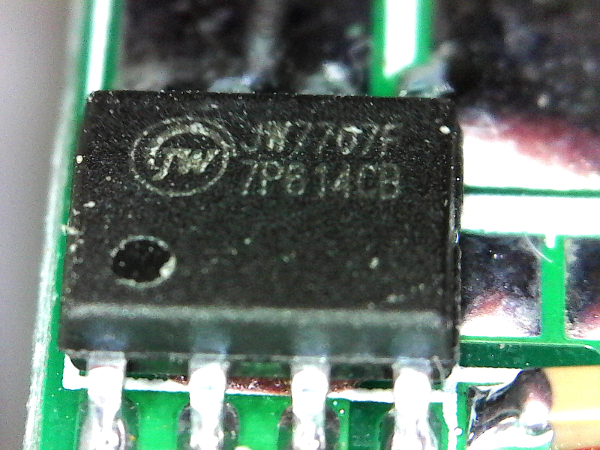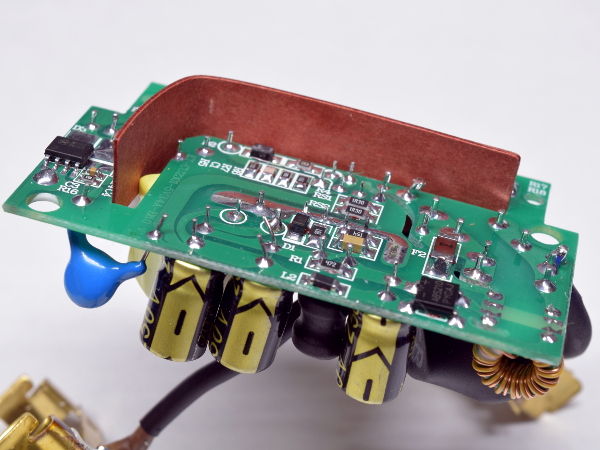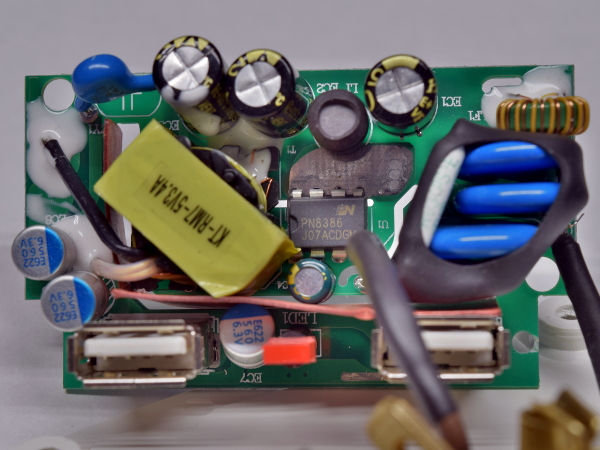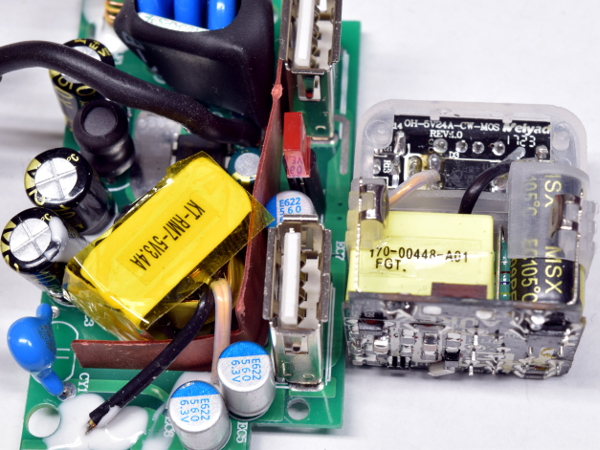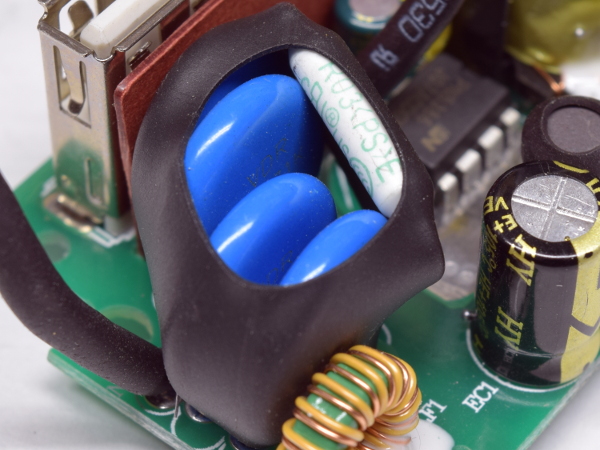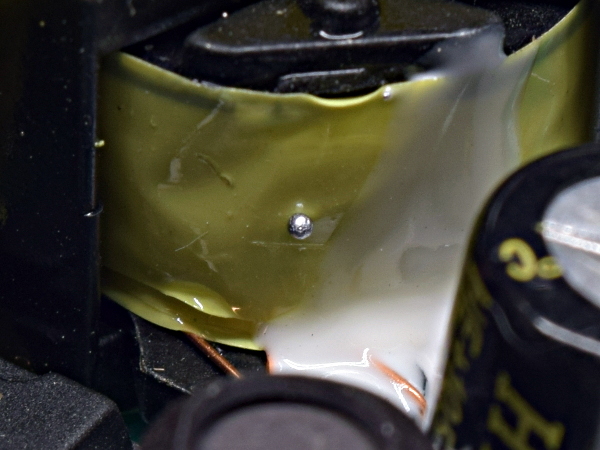AmazonBasics CU23011W Tap-Adapter: Top Performance, Imperfect Design
Near-Perfect Soldering
Out of all of this board's solder joints, the one on the right capacitor pad is the worst I could find. The second-worst has about half as much excess solder on it. The rest look just about right for surface-mount components that went through the solder wave process, as evidenced by the red glue under surface-mounted components that's there to prevent them from washing away.
JoulWho?
What is the mystery SO-8 chip for? As you may have guessed from its location in place of the diode footprints, the JW7707F is an integrated synchronous rectifier solution. The only external components it requires are a resistor and capacitor for snubbing switching transients (sometimes present in non-synchronous designs), along with a second pair for powering itself.
Who owns this unfamiliar logo and makes (or at least brands) the IC? A Chinese company called JoulWatt that specializes in power management products.
The Mystery SOT23-5
What does this RH7901A do? If you guessed it was a CX1901 single-port identification chip based on its location relative to one of the USB ports, you were almost correct. Apart from offering some extra package pin-out variants, the Rong He part appears to be otherwise equivalent as far as key datasheet values and tables are concerned.
Paper Please! (And Make It Flame-Retardant)
What is so special about putting a piece of cardboard inside an isolation slot? It inserts a physical barrier between the high- and low-voltage sides to contain most catastrophic failures. Arc flash may sputter material on the cardboard’s surface, but the paper's specific heat should quench it long before anything manages to get through. Worst case, flame-retardant materials don’t lose their battles without raising an overbearing stench.
A nice air gap is great, an air gap with a physical barrier floating in it is greater.
Board Top
This is one busy-looking board. Electricity’s trip through the circuit begins through the MOV cluster on the right, followed by the common-mode filter and capacitor bank before hitting the AC-DC converter chip driving the transformer. On the transformer’s secondary, all we see from the top is a bank of three polymer caps.
Get Tom's Hardware's best news and in-depth reviews, straight to your inbox.
Fairest Comparison
Among the adapters in my collection, Aukey’s PA-U32 is the closest match I could think of, and its assembly looks tiny next to the CU23011W. Of course, the Aukey doesn’t have MOVs and is rated for 1A less output current, which helps considerably with size reduction.
Comparing transformer cores, the CU23011W’s is about 20% wider and taller than Aukey’s, but about the same depth. That makes it approximately 50% bigger by volume, which is in line with its ~50% higher output rating (assuming they’re using similar core material and operate at similar frequencies).
Surge Protection
The CU23011W’s surge protection feature is provided by a set of four 14D331K MOVs in parallel, shrink-wrapped to their thermal protection fuse.
How does the “Protected” LED detect that the MOVs have gone bad? Simple: when MOVs fail, their leakage current rises, increasing their power dissipation and temperature until they get hot enough to blow the thermal fuse. Since the USB adapter circuitry is connected downstream from this fuse, the AC-DC converter loses power too. In essence, it is a glorified “On” indicator, as is nearly always the case.
Obligatory Stray Bead
If you look hard enough, you can probably find stray solder beads in just about any consumer electronic device. Here, we have a rather large ball approximately one millimeter in diameter barely hanging on the transformer’s tape, next to a splash of silicone adhesive.
Wire To Seemingly Nowhere
See that wire sticking out from the white goo near the top-right corner, skittering off behind the transformer tape wrap? Where could it possibly go that couldn't be handled within the coil form or through the board? Could it be stray excess wire that got taped over instead of trimmed? The only way to find out for certain is to expose it.
Final Destination
Where does this mystery wire end? Its final stop is seemingly nowhere in particular. However, I seriously doubt the wire’s tinned section happened to line up with the tape’s width and location by chance.
You may remember how some adapters in previous tear-downs failed my voltage withstand tests due to arcing between pins through the ferrite core. This wire is likely intended to pick up stray charges from the core before they ever get a chance to burn permanently conductive tracks into the coil form.
-
Daniel Sauvageau Readers wanted a break from generic no-name adapters. Here's something a little different.Reply -
Daniel Sauvageau Reply
They always are. Only one transformer, so no independent regulation. Only one transformer secondary and only one synchronous rectifier, so no isolation between outputs. No electronic fuses or PPTCs either, not really a problem when output current is only 4A with limited duty cycle.20964213 said:you never let us know if the two outputs where indeed connected in parallel.
I doubt we'll be seeing independently regulated 5V outputs in any adapter. At most, we might get a DC-DC converter in QC/USB-PD adapters with some fixed 5V ports. -
ElectrO_90 Americans and the use of Metric... doesn't compute! I need my 7/87ths of a inch measurement ;)Reply -
Daniel Sauvageau Reply
I'm Canadian :)20965184 said:Americans and the use of Metric... doesn't compute! I need my 7/87ths of a inch measurement ;) -
Onus I really enjoy these teardowns. Between you & Aris, it keeps my inner geek well-fed. When I buy a multi-socket adapter of most any kind, often it is to put somewhere, plug in devices that wouldn't fit otherwise, and just leave it, so I'm less concerned about the physical wear issues than a frequent-plugger might be.Reply -
zodiacfml It's not bad till that wiggly part. It will just not pass much current. This will burn soon when used in the kitchen.Reply
I have an extension cord with USB charging ports and six AC outlets, it just costs a bit more but certainly safer, convenient, and can pass more current. -
froozeball Wonderful dissection as always Sir!Reply
It's like watching Auguste Dupin or Sherlock Holmes unravel the threads in a mystery, forming an inescapable conclusion.
Thanks for putting this type of product on my radar M. Sauvageau!

